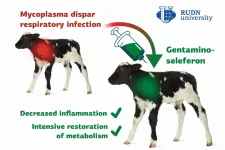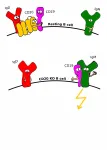A rare observation of a vampire bat adopting an unrelated pup
Among 21 adult bats in captivity, one female takes in an orphan
2021-02-10
(Press-News.org) COLUMBUS, Ohio - The death of a vampire bat 19 days after giving birth presented scientists studying the animals in 2019 with an unexpected chance to observe a rare event: a female bat's adoption of an unrelated baby.
The researchers had captured common vampire bats in Panama as part of ongoing studies of the formation of cooperative relationships among strangers. The team used infrared surveillance cameras to observe six hours of vampire bat activity spaced over the span of each day.
Two unrelated and unfamiliar female bats were observed forming a social bond based on mutual grooming and food sharing that increased over time. The researchers had named them BD and Lilith.
Lilith gave birth to a female pup about five weeks after the bats first met in captivity. As Lilith grew ill and spent less time caring for her pup, BD picked up the slack and even appeared to start nursing the baby. After Lilith died, BD adopted the pup, consistently nursing, grooming and sharing blood meals with the baby with almost no assistance from other adults in the colony.
"It's really cool that the little pup was adopted by the mother's closest social partner," said lead author Imran Razik, a graduate student in evolution, ecology and organismal biology at The Ohio State University.
"Even though it's a single observation, this method of recording social interactions every day for many hours allows us to contextualize it and better understand these social relationships. It's all about the social relationships."
The study is published today (Feb. 10, 2021) in Royal Society Open Science.
Razik works in the lab of senior author Gerald Carter, assistant professor of evolution, ecology and organismal biology at Ohio State, who studies vampire bat social behavior.
For this study, the team combined 23 adult and three juvenile common vampire bats captured from three distantly located roosts in the wild into a single captive colony, with plans to track how strangers developed social relationships over time.
Over four months, three surveillance cameras captured 652 hours of sampling periods, recording any cooperative behaviors that lasted at least five seconds. Vampire bats commonly groom each other and regurgitate their meals to feed roostmates that have been unsuccessful at getting their own meal of live animal blood. Carter's group fasts adult bats to induce costly investments of food sharing between recently introduced individuals.
The surveillance showed several clear trends. BD and Lilith increasingly groomed each other over time on an almost equal basis, and BD shared food with Lilith up until her death, even though Lilith did not frequently share food with BD. Lilith's grooming of her pup sharply declined shortly after birth, and her food-sharing interactions with the pup barely got off the ground. After Lilith died (of what the researchers believed was a gastrointestinal illness), BD provided steady grooming support to the pup, and her food-sharing with the baby noticeably increased. BD was still providing care to the pup at the end of the experiment.
BD's interactions with the baby actually began before Lilith died.
"I was noticing that sometimes the pup would lean over and attach to BD every now and then. And as Lilith was getting sick, I noticed the pup would spend more time near BD. I suppose Lilith didn't have the energy to raise the pup as she normally would have," Razik said.
Though the researchers don't know exactly when or by what mechanism, BD began to lactate. On the day Lilith died, Razik manually expressed milk from BD to confirm she would be able to nurse the pup that was "still in a stage of full dependency."
The researchers don't know why BD adopted Lilith's pup, but the adult vampire bats' social connection may provide clues.
"Both of these females had grooming relationships with several other bats in the colony, but those weren't as strong as the relationship they had with each other," Razik said. "This is only one observation, but it's interesting to speculate about what's going on."
INFORMATION:
This work was supported by the Smithsonian Tropical Research Institute, with which the authors are affiliated; the Animal Behavior Society; a graduate enrichment fellowship from Ohio State; a student research grant from Sigma Xi; and a Critical Difference for Women Professional Development Grant from Ohio State. Additional co-authors are Bridget Brown and Rachel Page, both from Ohio State.
Contact:
Imran Razik,
Razik.2@osu.edu
Written by Emily Caldwell,
Caldwell.151@osu.edu
ELSE PRESS RELEASES FROM THIS DATE:
2021-02-10
Respiratory tract diseases in young animals of the cattle are a big issue for world agriculture and food safety because a bacterium that causes them is resistant to most antibiotics. A team of veterinarians from RUDN University developed and tested a complex preparation called gentaminoseleferon that could help treat respiratory infection in calves. The results of the study were published in the Veterinary World journal.
Bacteria of the genus Mycoplasma cause many infectious diseases in animals, including atypical pneumonia, other respiratory tract conditions, reproductive pathologies, arthritis, keratoconjunctivitis, mastitis, and so on. The genus includes about 200 species of bacteria, and all of them ...
2021-02-10
Every day, people die from simple infections even though they have been treated with antibiotics. This is because more and more bacteria have become resistant to the types of antibiotics that doctors can prescribe.
- It's a huge societal problem and a crisis that we must solve. For example, by developing new antibiotics that can defeat the resistant bacteria, says professor of chemistry at the Department of Physics, Chemistry and Pharmacy, University of Southern Denmark, Poul Nielsen.
Resistant bacteria are not only known from pig farms, where it is becoming increasingly difficult to keep the pigsties disease-free. Hospitals are also experiencing with increasing regularity that, for example, infectious diseases cannot be controlled in patients. Thus, ...
2021-02-10
Can long-term stress lead to heart attacks? Most people would probably answer in the affirmative, but the scientific evidence of this is scarce. A new study by researchers from Linköping University in Sweden reveals that the levels of the stress hormone cortisol were increased in the months preceding a heart attack. The results, published in Scientific Reports, suggest that long-term stress is a risk factor for heart attacks.
"The levels of the stress hormone cortisol differed between people who have had a heart attack and those not affected. This suggests that cortisol in hair may be a new risk marker for heart attacks. We must take stress seriously", says Professor Tomas Faresjö from the Department of Health, ...
2021-02-10
Ruptured abdominal aortic aneurysms (rAAA) are responsible for nearly 2% of all deaths in U.S. men over the age of 65. Endovascular aneurysm repair (EVAR) has emerged as a newer and less invasive alternative to open repair for rAAA, and current guidelines recommend EVAR as a first-line option for treatment of rAAA when certain criteria are met. But researchers from the University of Missouri School of Medicine have discovered that while EVAR is more commonly utilized for rAA, shortens hospital stay and has a lower initial mortality rate, the odds of ...
2021-02-10
Researchers at the RIKEN Center for Biosystems Dynamics Research in Japan have discovered a recipe for continuous cyclical regeneration of cultured hair follicles from hair follicle stem cells.
Scientists have been making waves in recent years by developing ways to grow a variety of useful items in laboratories, from meat and diamonds to retinas and other organoids. At the RIKEN Center for Biosystems Dynamics Research in Japan, a team led by Takashi Tsuji has been working on ways to regenerate lost hair from stem cells. In an important step, a new study identifies a population of hair follicle stem cells in the skin and a recipe for normal cyclical regeneration in the lab.
The researchers took fur and whisker cells ...
2021-02-10
Experts from the Natural History Museum, The Francis Crick Institute and the Max Planck Institute for the Science of Human History Jena have joined together to untangle the different meanings of ancestry in the evolution of our species Homo sapiens.
Most of us are fascinated by our ancestry, and by extension the ancestry of the human species. We regularly see headlines like 'New human ancestor discovered' or 'New fossil changes everything we thought about our ancestry', and yet the meanings of words like ancestor and ancestry are rarely discussed in detail. In the new paper, published in Nature, experts review our current understanding of how modern human ancestry around the globe can be traced into the distant ...
2021-02-10
MINNEAPOLIS/ST.PAUL (02/10/2021) -- University of Minnesota Medical School researchers studied SARS-CoV-2 infections at individual cellular levels and made four major discoveries about the virus, including one that validates the effectiveness of remdesivir - an FDA-approved antiviral drug - as a form of treatment for severe COVID-19 disease.
"Since the start of the COVID-19 pandemic, the way that each individual responds differently to the infection has been closely studied. In our new study, we examined variations in the way individual cells reacted differently to the coronavirus and responded to antiviral treatment," said Ryan Langlois, PhD, senior author of the study, associate professor in the Department ...
2021-02-10
PHILADELPHIA -- Past exposure to seasonal coronaviruses (CoVs), which cause the common cold, does not result in the production of antibodies that protect against the novel coronavirus SARS-CoV-2, according to a study led by Scott Hensley, PhD, an associate professor of Microbiology at the Perelman School of Medicine at the University of Pennsylvania.
Prior studies have suggested that recent exposure to seasonal CoVs protects against SARS-CoV-2, the virus that causes COVID-19. However, research from Hensley's team, published in Cell, suggests that if there is such protection, it does not come from antibodies.
"We found that many people possessed antibodies that could bind to SARS-CoV-2 before the pandemic, but these antibodies could not prevent infections," Hensley said. ...
2021-02-10
Researchers from the University of Basel have developed a virtual reality app for smartphones to reduce fear of heights. Now, they have conducted a clinical trial to study its efficacy. Trial participants who spent a total of four hours training with the app at home showed an improvement in their ability to handle real height situations.
Fear of heights is a widespread phenomenon. Approximately 5% of the general population experiences a debilitating level of discomfort in height situations. However, the people affected rarely take advantage of the available treatment options, such as exposure therapy, which involves putting the person in the anxiety-causing situation under the guidance of a professional. On the one hand, people ...
2021-02-10
Rituximab, an anti-cancer drug targeting the membrane protein CD20, was the first approved therapeutic antibody against B tumor cells. Immunologists at the University of Freiburg have now solved a mystery about how it works. A team headed by Professor Dr. Michael Reth used cell cultures, healthy cells, and cells from cancer patients to investigate how CD20 organizes the nanostructures on the B cell membrane. If the protein is missing or Rituximab binds to it, the organization of the B cell surface changes. The resting B cell is activated in the process. The team has published the research in the journal PNAS as part of contributions by new members of the National Academy of Science.
B cells are white blood cells and part of the immune system. When they recognize ...
LAST 30 PRESS RELEASES:
[Press-News.org] A rare observation of a vampire bat adopting an unrelated pup
Among 21 adult bats in captivity, one female takes in an orphan






